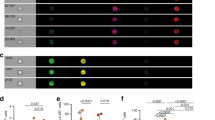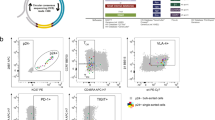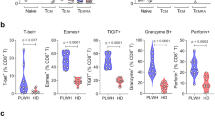Abstract
A mechanistic understanding of HIV-1 latency depends on a model system that recapitulates the in vivo condition of latently infected, resting CD4+ T lymphocytes. Latency seems to be established after activated CD4+ T cells, the principal targets of HIV-1 infection, become productively infected and survive long enough to return to a resting memory state in which viral expression is inhibited by changes in the cellular environment. This protocol describes an ex vivo primary cell system that is generated under conditions that reflect the in vivo establishment of latency. Creation of these latency model cells takes 12 weeks and, once established, the cells can be maintained and used for several months. The resulting cell population contains both uninfected and latently infected cells. This primary cell model can be used to perform drug screens, to study cytolytic T lymphocyte (CTL) responses to HIV-1, to compare viral alleles or to expand the ex vivo life span of cells from HIV-1-infected individuals for extended study.
This is a preview of subscription content, access via your institution
Access options
Subscribe to this journal
Receive 12 print issues and online access
$259.00 per year
only $21.58 per issue
Buy this article
- Purchase on Springer Link
- Instant access to full article PDF
Prices may be subject to local taxes which are calculated during checkout








Similar content being viewed by others
References
Chun, T.W. et al. Quantification of latent tissue reservoirs and total body viral load in HIV-1 infection. Nature 387, 183–188 (1997).
Chun, T.W. et al. In vivo fate of HIV-1-infected T cells: quantitative analysis of the transition to stable latency. Nat. Med. 1, 1284–1290 (1995).
Wong, J.K. et al. Recovery of replication-competent HIV despite prolonged suppression of plasma viremia. Science 278, 1291–1295 (1997).
Siliciano, J.D. et al. Long-term follow-up studies confirm the stability of the latent reservoir for HIV-1 in resting CD4+ T cells. Nat. Med. 9, 727–728 (2003).
Finzi, D. et al. Identification of a reservoir for HIV-1 in patients on highly active antiretroviral therapy. Science 278, 1295–1300 (1997).
Samji, H. et al. Closing the gap: increases in life expectancy among treated HIV-positive individuals in the United States and Canada. PLoS ONE 8, e81355 (2013).
Davey, R.T. Jr. et al. HIV-1 and T cell dynamics after interruption of highly active antiretroviral therapy (HAART) in patients with a history of sustained viral suppression. Proc. Natl. Acad. Sci. USA 96, 15109–15114 (1999).
Hamer, D.H. Can HIV be cured? Mechanisms of HIV persistence and strategies to combat it. Curr. HIV Res. 2, 99–111 (2004).
Archin, N.M. & Margolis, D.M. Emerging strategies to deplete the HIV reservoir. Curr. Opin. Infect. Dis. 27, 29–35 (2014).
Schroder, A.R. et al. HIV-1 integration in the human genome favors active genes and local hotspots. Cell 110, 521–529 (2002).
Jordan, A., Bisgrove, D. & Verdin, E. HIV reproducibly establishes a latent infection after acute infection of T cells in vitro. EMBO J. 22, 1868–1877 (2003).
Gautier, V.W. et al. In vitro nuclear interactome of the HIV-1 Tat protein. Retrovirology 6, 47 (2009).
Jager, S. et al. Global landscape of HIV-human protein complexes. Nature 481, 365–370 (2012).
Spina, C.A., Guatelli, J.C. & Richman, D.D. Establishment of a stable, inducible form of human immunodeficiency virus type 1 DNA in quiescent CD4 lymphocytes in vitro. J. Virol. 69, 2977–2988 (1995).
Swiggard, W.J. et al. Human immunodeficiency virus type 1 can establish latent infection in resting CD4+ T cells in the absence of activating stimuli. J. Virol. 79, 14179–14188 (2005).
Saleh, S. et al. CCR7 ligands CCL19 and CCL21 increase permissiveness of resting memory CD4+ T cells to HIV-1 infection: a novel model of HIV-1 latency. Blood 110, 4161–4164 (2007).
Yang, H.C. et al. Small-molecule screening using a human primary cell model of HIV latency identifies compounds that reverse latency without cellular activation. J. Clin. Invest. 119, 3473–3486 (2009).
Bosque, A. & Planelles, V. Studies of HIV-1 latency in an ex vivo model that uses primary central memory T cells. Methods 53, 54–61 (2011).
Lassen, K.G., Hebbeler, A.M., Bhattacharyya, D., Lobritz, M.A. & Greene, W.C. A flexible model of HIV-1 latency permitting evaluation of many primary CD4 T cell reservoirs. PLoS ONE 7, e30176 (2012).
Spina, C.A. et al. An in-depth comparison of latent HIV-1 reactivation in multiple cell model systems and resting CD4+ T cells from aviremic patients. PLoS Pathog. 9, e1003834 (2013).
Bosque, A. & Planelles, V. Induction of HIV-1 latency and reactivation in primary memory CD4+ T cells. Blood 113, 58–65 (2009).
Xing, S. et al. Disulfiram reactivates latent HIV-1 in a Bcl-2-transduced primary CD4+ T cell model without inducing global T cell activation. J. Virol. 85, 6060–6064 (2011).
Xing, S. et al. Novel structurally related compounds reactivate latent HIV-1 in a Bcl-2–transduced primary CD4+ T cell model without inducing global T cell activation. J. Antimicrob. Chem. 67, 398–403 (2012).
Miller, L.K. et al. Proteasome inhibitors act as bifunctional antagonists of human immunodeficiency virus type 1 latency and replication. Retrovirology 10, 120 (2013).
Boehm, D. et al. BET bromodomain-targeting compounds reactivate HIV from latency via a Tat-independent mechanism. Cell Cycle 12, 452–462 (2013).
Spivak, A.M. et al. A pilot study assessing the safety and latency-reversing activity of disulfiram in HIV-1-infected adults on antiretroviral therapy. Clin. Infect. Dis. 58, 883–890 (2014).
Shan, L. et al. Stimulation of HIV-1-specific cytolytic T lymphocytes facilitates elimination of latent viral reservoir after virus reactivation. Immunity 36, 491–501 (2012).
Dahabieh, M.S., Ooms, M., Simon, V. & Sadowski, I. A doubly fluorescent HIV-1 reporter shows that the majority of integrated HIV-1 is latent shortly after infection. J. Virol. 87, 4716–4727 (2013).
Calvanese, V., Chavez, L., Laurent, T., Ding, S. & Verdin, E. Dual-color HIV reporters trace a population of latently infected cells and enable their purification. Virology 446, 283–292 (2013).
Naldini, L. et al. In vivo gene delivery and stable transduction of nondividing cells by a lentiviral vector. Science 272, 263–267 (1996).
Mochizuki, H., Schwartz, J.P., Tanaka, K., Brady, R.O. & Reiser, J. High-titer human immunodeficiency virus type 1-based vector systems for gene delivery into nondividing cells. J. Virol. 72, 8873–8883 (1998).
Acknowledgements
We thank all members of the Siliciano laboratory, past and present, who have contributed to the development and testing of the Bcl-2 model cells. This work was supported by the Martin Delaney Collaboratory of AIDS researchers for Eradication (CARE) and Delaney AIDS Research Enterprise (DARE) Collaboratories (US National Institutes of Health (NIH) grants AI096113 and 1U19AI096109), by an amfAR Research Consortium on HIV Eradication (ARCHE) Collaborative Research Grant from the Foundation for AIDS Research (amfAR 108165-50-RGRL), by the Johns Hopkins Center for AIDS Research, by NIH grant 43222 and by the Howard Hughes Medical Institute.
Author information
Authors and Affiliations
Contributions
H.-C.Y. and R.F.S. conceived and developed the original Bcl-2 model cell system; M.K. modified the protocol and wrote the manuscript; M.K., N.N.H. and C.K.B. performed experiments; and all authors reviewed the manuscript.
Corresponding author
Ethics declarations
Competing interests
The authors declare no competing financial interests.
Rights and permissions
About this article
Cite this article
Kim, M., Hosmane, N., Bullen, C. et al. A primary CD4+ T cell model of HIV-1 latency established after activation through the T cell receptor and subsequent return to quiescence. Nat Protoc 9, 2755–2770 (2014). https://doi.org/10.1038/nprot.2014.188
Published:
Issue Date:
DOI: https://doi.org/10.1038/nprot.2014.188
This article is cited by
-
STING agonists activate latently infected cells and enhance SIV-specific responses ex vivo in naturally SIV controlled cynomolgus macaques
Scientific Reports (2019)
-
The CCR5-antagonist Maraviroc reverses HIV-1 latency in vitro alone or in combination with the PKC-agonist Bryostatin-1
Scientific Reports (2017)
-
HIV-infected macrophages and microglia that survive acute infection become viral reservoirs by a mechanism involving Bim
Scientific Reports (2017)
-
HIV-1 cellular and tissue replication patterns in infected humanized mice
Scientific Reports (2016)
-
Defective proviruses rapidly accumulate during acute HIV-1 infection
Nature Medicine (2016)
Comments
By submitting a comment you agree to abide by our Terms and Community Guidelines. If you find something abusive or that does not comply with our terms or guidelines please flag it as inappropriate.



